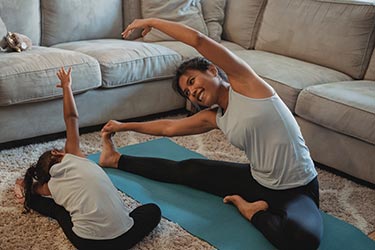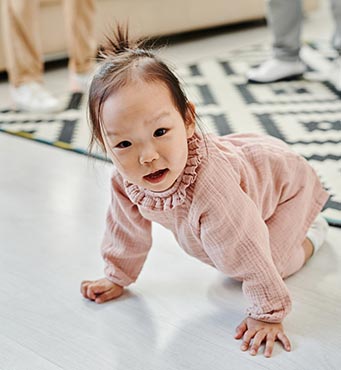Proprioception Overview

Proprio-WHAT?!
If your child receives occupational therapy, chances are you’ve heard the term “proprioception” before. Your child’s OT may say something like, “your child tends to seek out proprioceptive input” or that “your child benefits from proprioceptive input during moments of dysregulation.” But what does that really mean? Squeezes? Crashes on the crash pad? The following is a quick overview of what proprioception is, why it’s important, and several ways for your child to get proprioceptive input at home!
What is it?
When considering your child’s sensory system, occupational therapists are thinking about seven different senses: sight, hearing, smell, taste, touch, vestibular, and proprioception. Proprioception can be thought of as our sense of body awareness and where our body parts are in space. More technically speaking, we get proprioceptive input when receptors (called proprioceptors) in our muscles and joints are stimulated. When we do activities that apply pressure to our joints, we are receiving proprioceptive input!
Why is it important?
As I mentioned above, proprioception allows us to know where our body is in space. That means that it helps us with coordination, posture, body awareness, self-regulation, and a whole lot more. Imagine trying to pick up a glass of water to take a drink but being unable to judge how wide to open your hand to grasp the glass, or not holding it tight enough so it slips out of your hand, or miscalculating how much you need to extend your arm to grab the glass and it spills. Our proprioceptive sense helps us accurately and appropriately complete each of these little steps that allow us to take that drink of water – and do SO much more!
What are some examples?
There are a LOT of things that can be done to provide your child (or yourself!) with proprioceptive input. To start, remember that proprioceptive input always involves the joints and muscles. So, for example, squeezing your child’s upper arms would not qualify as proprioceptive input but rather deep tactile pressure because the joints are not involved. For proprioceptive input on the arms, “wall push-ups” (pushing against the wall with elbows flexed) are a great place to start! Some other examples include:
- Jumping and crashing on a crash pad: the impact of landing on a crash pad or large cushion provides lots of proprioceptive input due to the full body making contact with the cushion. Lots of joints and muscles are involved in this action!
- Weightbearing activities: activities that require your child to bear weight on their limbs are great ways to get proprioceptive input. Examples of these can include crawling/animal walks, push-ups (wall or floor), wheelbarrow walks, planks, doing activities on the tummy while propped up on elbows, and yoga!
- “Heavy work” activities: “heavy work” activities involve pushing or pulling heavy objects. Examples include pushing furniture, pushing someone on a swing, pulling a resistance band, pulling on a rope while on a skateboard or scooter board, pushing a vacuum, or pushing a shopping cart.
- Joint compressions: this activity involves compressing your child’s joints together for a few seconds at a time. This is an activity that requires training from an experienced OT, so ask an OT if this sounds like a good fit for your child!

Eyas Landing is a therapy clinic with a mission to provide evidence-based and family-centered therapy services for children, adolescents, and their families. The primary goal is to deliver relationship-based interventions within the most natural environments and to empower families to reach their full potential. To achieve this goal, our highly educated, compassionate staff dedicates time and expertise to create experiences that maximize therapeutic outcomes. The strength, determination, and perseverance of our clients are evident as they succeed in therapy, and ultimately in their daily lives.
Eyas Landing offers a wide range of comprehensive services including Speech Therapy, Occupational Therapy, Physical Therapy, ABA Therapy, Social Work, Family Therapy, and Neuropsych testing. Services are provided throughout the Chicagoland area via Telehealth, In-Home, and in our state of the art clinic.
Want to learn more or you have a specific question? Feel free to connect with us here!



